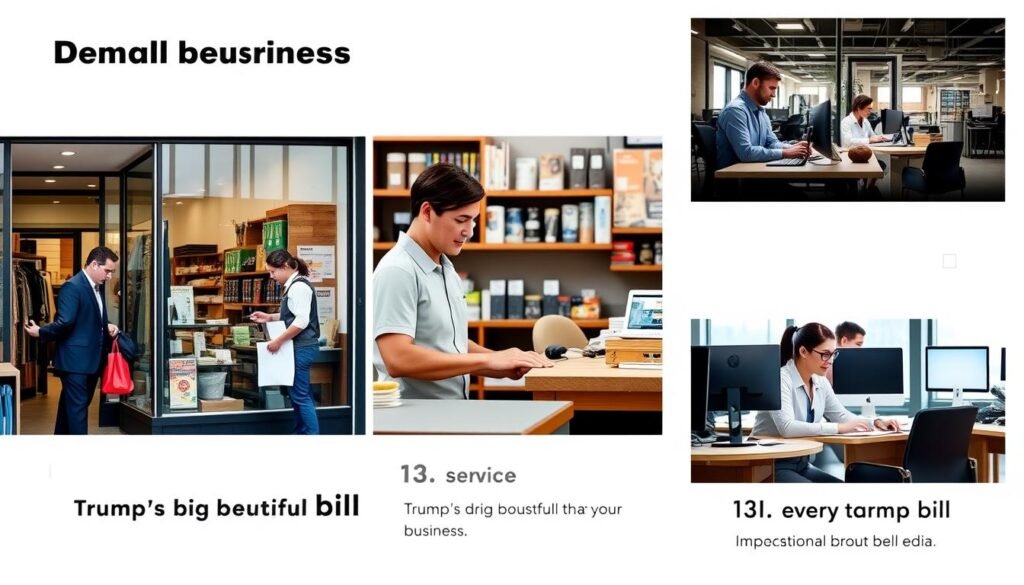President Donald Trump’s “Big Beautiful Bill” has now been signed into law, bringing sweeping changes to America’s economic landscape. For the nation’s 33 million small businesses that employ nearly half of all U.S. workers, this legislation presents both opportunities and potential hurdles. As the backbone of the American economy, small business owners are now scrambling to understand how these changes will affect their bottom line, healthcare costs, access to capital, and regulatory burden.
The nearly 900-page legislation makes permanent Trump’s 2017 tax cuts while adding new relief measures, including deductions for overtime pay and auto loans. However, it also enacts deep spending cuts to social safety net programs such as Medicaid and food stamp benefits, which could indirectly impact many small business communities, particularly in rural areas.
This comprehensive analysis breaks down what small business owners need to know about Trump’s Big Beautiful Bill, examining whether it offers genuine relief or creates new challenges for America’s entrepreneurs.
Tax Cuts and Extensions: What Small Businesses Can Expect
The centerpiece of Trump’s Big Beautiful Bill is the permanent extension of the 2017 Tax Cuts and Jobs Act (TCJA) provisions that were set to expire after 2025. For small businesses, particularly pass-through entities like S-corporations, partnerships, and sole proprietorships, this means the continuation of the 20% qualified business income deduction under Section 199A.
“Making the Section 199A deduction permanent provides much-needed certainty for small business planning,” says John Arensmeyer, founder of Small Business Majority. “However, the benefits aren’t distributed equally across all small businesses, with larger pass-through entities typically seeing greater advantages.”
Key Tax Provisions Affecting Small Businesses
- Permanent extension of the 20% qualified business income deduction (Section 199A)
- Temporary tax deduction of up to $25,000 per year on qualified tip income through 2028
- Maximum $12,500 above-the-line deduction for overtime pay ($25,000 for married couples filing jointly) from 2025 to 2028
- Increased standard deduction from $15,000 to $15,750 (single) and $30,000 to $31,500 (married filing jointly)
- Temporary deduction for car loan interest of up to $10,000 annually through 2028
The bill also raises the state and local tax (SALT) deduction cap from $10,000 to $40,000 starting in 2025, with 1% increases through 2029 before reverting to $10,000 in 2030. This change could significantly benefit small business owners in high-tax states like California, New York, and New Jersey.
Potential Benefits
- Tax certainty for long-term business planning
- Continued 20% deduction on qualified business income
- New deductions for overtime and tip income
- Higher SALT deduction cap for businesses in high-tax states
- Immediate equipment write-offs could stimulate investment
Potential Challenges
- Benefits skew toward larger small businesses
- Temporary nature of some deductions creates future uncertainty
- Increased federal deficit could lead to higher interest rates
- Complexity of tax code remains a burden for smallest businesses
- Social program cuts may impact consumer spending in some communities
According to the Congressional Budget Office analysis, the bill contains roughly $4.5 trillion in tax cuts. While higher-income households will see the largest benefits in dollar terms, many small business owners will find themselves in this category, particularly those with successful pass-through entities.
Get Your Free Small Business Tax Guide
Download our comprehensive guide to maximizing your tax benefits under Trump’s Big Beautiful Bill. Includes sector-specific strategies, deduction worksheets, and planning calendars.
Healthcare Impacts: Medicaid Changes and Small Business Concerns

The legislation’s approximately $1 trillion in Medicaid cuts over the next decade presents significant concerns for small businesses, particularly those in rural and underserved communities. New federal work rules will require beneficiaries ages 19 to 64 to work at least 80 hours per month, with implementation beginning December 31, 2026, for most states.
For small business owners who rely on Medicaid for their own healthcare or have employees who do, these changes could create workforce challenges. The Congressional Budget Office estimates that about 7.8 million people could become uninsured by 2034 due to these Medicaid cuts.
Key Healthcare Changes Affecting Small Businesses
| Provision | Implementation Date | Potential Impact on Small Businesses |
| Medicaid work requirements (80 hours/month) | Dec 31, 2026 | May reduce available workforce in some communities; increased employee turnover |
| Six-month eligibility redeterminations | 2025 | Administrative burden for employees maintaining coverage; potential coverage gaps |
| New $35 Medicaid co-payment | 2025 | Increased out-of-pocket costs for business owners and employees on Medicaid |
| Limits on state provider taxes | Gradual through 2032 | Potential reduction in rural healthcare access; higher private insurance costs |
“Small businesses in rural communities are particularly vulnerable to these Medicaid changes,” explains Dr. Leighton Ku, Professor of Health Policy at George Washington University. “When rural hospitals face funding challenges due to Medicaid cuts, it creates healthcare deserts that make it harder for small businesses to attract and retain workers.”
The bill also eliminates several clean energy tax credits that had benefited small businesses investing in sustainability. The $7,500 tax credit for electric vehicles and incentives for energy-efficient improvements will disappear after September 30, 2025, potentially impacting small businesses in the green economy sector.
Access to Capital and Interest Rate Implications

The Congressional Budget Office estimates that Trump’s Big Beautiful Bill could add $3.3 trillion to federal deficits over the next decade. This substantial increase in government borrowing has implications for interest rates and, consequently, small business access to capital.
While the bill doesn’t directly address Small Business Administration (SBA) lending programs, the macroeconomic effects of increased deficit spending could indirectly impact small business borrowing costs. Higher government borrowing typically puts upward pressure on interest rates across the economy.
Interest Rate Considerations for Small Business Owners
Short-Term Outlook
The immediate impact on interest rates may be limited as markets have already priced in expectations of the legislation. However, small business owners should monitor Federal Reserve policy closely, as increased government borrowing could influence future rate decisions.
The auto loan interest deduction of up to $10,000 annually could provide some relief for small businesses with vehicle fleets, though the benefit is relatively modest according to experts.
Long-Term Considerations
As government debt increases over time, the potential for “crowding out” private investment grows. This could make capital access more challenging for small businesses, particularly those without established banking relationships.
Small business owners should consider locking in current financing terms where possible and exploring alternative funding sources such as community development financial institutions (CDFIs) that may be less sensitive to market interest rate fluctuations.
James Lucier of Capital Alpha Partners noted that “the size of Trump’s megabill will be the size of the debt,” highlighting the significant fiscal implications of the legislation. For small business owners, this means staying vigilant about how macroeconomic factors could affect their borrowing costs in the coming years.
Sector-Specific Impacts on Small Businesses

Retail and Consumer-Facing Businesses
For retail small businesses, the bill presents a mixed picture. Tax cuts may provide some relief to business owners, but cuts to food assistance through the Supplemental Nutrition Assistance Program (SNAP) could reduce consumer spending in certain communities.
The legislation expands existing work requirements for SNAP to include adults ages 55 to 64 and parents with children 14 and over. An estimated 5.3 million families could lose at least $25 in SNAP benefits per month, with an average loss of $146 monthly according to the Urban Institute.
“Small retailers in low-income communities often rely heavily on SNAP spending,” explains Dr. Elizabeth Racine, Professor of Public Health at UNC Charlotte. “When these benefits are reduced, we typically see corresponding reductions in local grocery and retail spending, which can significantly impact small businesses in these areas.”
Service Industry Businesses

Service industry small businesses may see significant benefits from the temporary federal income tax deduction of up to $25,000 per year on qualified tip income. This provision could help restaurants, salons, and other service businesses where tipping is common.
However, the Medicaid work requirements could create staffing challenges in industries that rely on part-time or seasonal workers. Small business owners in the service sector should prepare for potential workforce disruptions as these requirements take effect.
Technology and Innovation Startups
For technology startups and innovative small businesses, the elimination of clean energy tax credits represents a significant change. The bill ends several consumer tax credits tied to clean energy, including the $7,500 tax credit for electric vehicles and incentives for energy-efficient home improvements.
These changes could impact small businesses in the green economy sector, from solar installation companies to energy efficiency consultants. However, the bill’s provisions for immediate equipment write-offs could benefit tech startups making significant capital investments.
How does Trump’s Big Beautiful Bill differ from the 2017 Tax Cuts and Jobs Act for small businesses?
While the 2017 TCJA created temporary tax cuts set to expire after 2025, the Big Beautiful Bill makes these cuts permanent, including the crucial 20% qualified business income deduction (Section 199A). The new legislation also adds several temporary deductions not present in the original TCJA, including deductions for tip income, overtime pay, and auto loan interest. However, unlike the 2017 law, the new bill includes significant cuts to social programs like Medicaid and SNAP that could indirectly impact small business communities.
Will small businesses benefit from the increased SALT deduction cap?
Small business owners in high-tax states like California, New York, New Jersey, Connecticut, and Massachusetts will likely benefit from the increased SALT deduction cap, which rises from $10,000 to $40,000 starting in 2025. This is particularly valuable for pass-through business owners who pay state and local taxes on their business income through their personal returns. However, the benefit begins to phase out for those with incomes above $500,000, and the cap will revert to $10,000 in 2030 without further legislative action.
How might Medicaid cuts affect small business hiring?
The Medicaid work requirements and funding cuts could create workforce challenges for small businesses, particularly in rural and low-income areas. As an estimated 7.8 million people could lose health coverage by 2034, small businesses may face increased difficulty attracting and retaining workers in communities with limited healthcare access. Additionally, employees transitioning from Medicaid to employer-sponsored insurance could increase benefit costs for small businesses that offer health coverage.
Regional Variations: How Location Affects Small Business Impacts
The impact of Trump’s Big Beautiful Bill on small businesses varies significantly by region, with state tax policies, rural/urban divides, and industry concentrations creating different outcomes across the country.
High-Tax States vs. Low-Tax States
Small business owners in high-tax states like California, New York, New Jersey, Connecticut, and Massachusetts stand to benefit significantly from the increased SALT deduction cap. In 2022, the average SALT deduction was close to $10,000 in these states, indicating that many taxpayers were hitting the previous cap.
Meanwhile, small businesses in low-tax states may see fewer direct benefits from the SALT changes but could still benefit from the permanent extension of the 2017 tax cuts and new deductions for overtime and tip income.
Rural vs. Urban Small Businesses
Rural small businesses face unique challenges under the legislation. The Medicaid funding cuts could disproportionately impact rural hospitals, potentially creating healthcare deserts that make it harder for rural small businesses to attract and retain workers.
The Senate bill did include a $50 billion rural hospital fund to help offset some of these impacts, but concerns remain about long-term healthcare access in rural communities. Urban small businesses, while not immune to healthcare challenges, typically have more provider options available to their workforce.
| Region Type | Potential Benefits | Potential Challenges |
| High-Tax States (CA, NY, NJ, CT, MA) | Increased SALT deduction cap; permanent tax cut extensions | Higher cost of doing business; potential workforce impacts from Medicaid changes |
| Low-Tax States (TX, FL, TN, WY, NV) | Permanent tax cut extensions; overtime and tip income deductions | Less benefit from SALT changes; potential SNAP cuts affecting consumer spending |
| Rural Communities | $50B rural hospital fund; permanent tax cut extensions | Medicaid funding pressures on rural healthcare; workforce attraction challenges |
| Urban Centers | Permanent tax cut extensions; greater healthcare provider options | Higher operating costs; potential impacts from SNAP benefit reductions |
Future Outlook and Planning Considerations

Small business owners face a complex planning environment as various provisions of Trump’s Big Beautiful Bill phase in and out over different timeframes. Creating a strategic timeline can help entrepreneurs maximize benefits while preparing for potential challenges.
Key Implementation Dates for Small Business Planning
2025
- Permanent extension of 2017 tax cuts takes effect
- SALT deduction cap increases to $40,000
- Tip income and overtime deductions become available
- Auto loan interest deduction begins
2026-2028
- Medicaid work requirements begin (Dec 31, 2026)
- Senior tax “bonus” deduction available through 2028
- Temporary deductions continue (tips, overtime, auto loans)
- Clean energy tax credits fully phased out
2029-2034
- SALT deduction cap reverts to $10,000 in 2030
- Temporary deductions expire
- Full impact of Medicaid changes realized
- Long-term deficit impacts on interest rates may increase
Small business owners should work with financial advisors to create a strategic plan that maximizes available tax benefits while preparing for the expiration of temporary provisions. Additionally, businesses in sectors or regions particularly affected by Medicaid or SNAP changes should develop workforce and market strategies to address potential challenges.
“The temporary nature of many provisions creates both opportunities and risks,” explains Mark Mazur, former Director of the Urban-Brookings Tax Policy Center. “Small business owners who plan strategically can maximize short-term benefits while positioning themselves for the eventual expiration of these temporary measures.”
Stay Informed as Implementation Unfolds
Download our comprehensive guide to Trump’s Big Beautiful Bill and its impact on small businesses. Includes implementation timelines, planning worksheets, and sector-specific strategies.
Conclusion: Navigating the New Small Business Landscape

Trump’s Big Beautiful Bill presents small business owners with a complex mix of opportunities and challenges. The permanent extension of the 2017 tax cuts provides certainty for business planning, while new deductions for tip income, overtime pay, and auto loans offer additional relief for specific sectors.
However, the legislation’s cuts to Medicaid and food assistance programs could create workforce and market challenges, particularly in rural and low-income communities. The potential long-term impact of increased deficit spending on interest rates also bears watching for small business owners concerned about capital access.
As with any major legislation, the true impact will emerge over time as implementation unfolds and markets adjust. Small business owners who stay informed, plan strategically, and remain adaptable will be best positioned to navigate this evolving landscape.
The question remains: Will Trump’s Big Beautiful Bill ultimately strengthen America’s small business ecosystem, or will its benefits be unevenly distributed across regions, sectors, and business sizes? The answer likely depends on where your business is located, what industry you’re in, and how effectively you can leverage the bill’s provisions while mitigating its potential challenges.
Frequently Asked Questions
When do the tax provisions in Trump’s Big Beautiful Bill take effect?
Most tax provisions take effect in 2025, including the permanent extension of the 2017 tax cuts, the increased SALT deduction cap, and new deductions for tip income, overtime pay, and auto loan interest. Some provisions are temporary, with tip income, overtime, and auto loan deductions scheduled to expire after 2028.
How will the bill affect small business healthcare costs?
The bill’s Medicaid changes could indirectly affect small business healthcare costs. As an estimated 7.8 million people lose Medicaid coverage by 2034, some may seek employer-sponsored insurance, potentially increasing costs for small businesses that offer health benefits. Additionally, Medicaid funding cuts could pressure rural hospitals, potentially reducing healthcare access in some communities.
Are there any specific provisions for startup businesses?
While the bill doesn’t include provisions specifically targeted at startups, new businesses can benefit from the permanent extension of the Section 199A deduction for pass-through entities and the ability to immediately write off equipment purchases. However, the elimination of clean energy tax credits could impact startups in the green economy sector.
How might the increased deficit affect small business lending?
The Congressional Budget Office estimates the bill could add $3.3 trillion to federal deficits over the next decade. Increased government borrowing typically puts upward pressure on interest rates, which could eventually increase borrowing costs for small businesses. While the immediate impact may be limited, small business owners should monitor long-term interest rate trends.
What should small business owners do to prepare for these changes?
Small business owners should consult with tax professionals to understand how specific provisions affect their situation, create a strategic timeline for when different provisions phase in and out, assess potential workforce impacts from Medicaid and SNAP changes, review capital needs and financing options in anticipation of potential interest rate changes, and stay informed as implementation details emerge from federal agencies.
